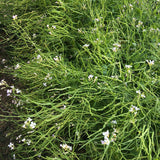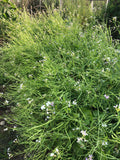Rat-Tail Radish (Burma)
Raphanus sativus, var. caudatus
This is the preferred variety of “rat-tail radish” grown by Karen farmers from Burma who grow at Novick Urban Farm in South Philadelphia - it has smaller and more tender pods than other varieties with a sweet and spicy flavor.
Native to South Asia, this variety was collected from Karen farmers in the hills of Myanmar. It is called Thaba Paw Wah or Ta Ba Par (White Mustard Flower), though in the US we know it as Rat-Tail Radish. While botanically it is a type of radish, Karen people adore this plant for the leaves and edible flowers as well as the pods. The young white flower shoots are delicious blanched or cooked in simple soups and can be eaten as a side to any meal. The pods are eaten raw as a snack in the field, at home dipped in fish/chili paste, on the side of pickled tea leaf salad, or used in a spicy chicken or fish soup with other garden vegetables. Karen refugees come often to our farm to buy this variety as they say the rich flavor reminds them of home, gives them energy throughout the day, and helps elders and kids who are feeling weak.
Days to maturity: 50
Seeds per pack: 100
Germination rate: 95% on 09/16/2025
Planting / harvesting notes
Direct seed 3 inches apart in rows 12 inches apart in early spring through summer. Succession plantings every 3-4 weeks can provide continual harvest later in the season. It is heat tolerant, but does best in spring. This variety will thrive in most soil conditions, but loose fertile soil is best. Plants have very vigorous growth and prolific production reaching over 5’ tall and branching out in all directions, so give them plenty of room. Plants can be staked, trellised, or caged for easy picking. The pods don’t ripen uniformly, so pick over 2-4 weeks. The more you pick, the more they produce. The immature pods should be picked when they are a skinny bean size, and before the seeds form. For cooking, you can pick slightly larger pods as well.
Seed keeping notes
For seed saving, leave them in for 65-80 days until the pods fully dry and become crunchy/crispy. Harvest the seedhead below the lowest ripe seed pods, and hang in a sunny, dry place if it needs to dry a little more. Thresh seed pods by pushing through screens, rubbing between your hands, or stomping in buckets. Sift out larger chaff and use wind, breath, or fans to winnow away the lighter weight chaff from the seed.







